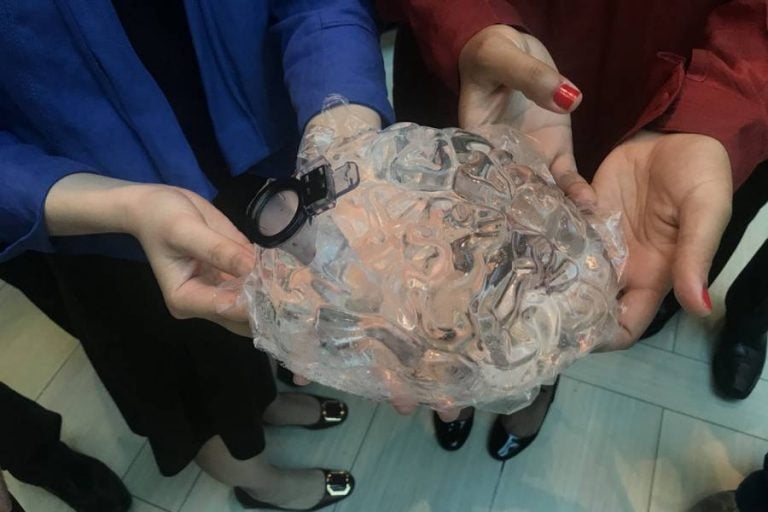Undergraduate team developed Radiex device to hold back cortical tissue during brain surgery

For the ninth year in a row, a team of Johns Hopkins University students will participate in the Collegiate Inventors Competition. The challenge, hosted this week by the National Inventors Hall of Fame in Washington, D.C., awards students for innovation, potential, and solutions to real-world problems.
This year, a group of Hopkins biomedical engineering students will submit Radiex, a brain retractor that aims to reduce the likelihood of injury during surgery. Brain retractors—the devices used to pull back cortical tissue—cause injury in about nine percent of neurosurgical operations, often due to a design that is inflexible or exerts too much pressure.
Radiex, by contrast, boasts a rounded design, meaning radial pressure is distributed. Its small point of entry allows for a minimally invasive operation, and the point of insertion can be adjusted and expanded mid-procedure, a feature current devices lack.
The innovative design, developed by Team CortiTech, is the product of more than a year of brainstorming, prototyping, testing, and retesting.
“We call it the spiral model. [We] make the prototype, [we] test it ourselves, we give it to the surgeons, we get their feedback,” said sophomore team member Jody Mou, who estimated the team has made about 20 to 30 prototypes so far.
Mou will represent Team CortiTech in Washington, D.C., at the event on Friday, Nov. 16, along with senior Linh Tran and sophomore Kevin Tu. Other team members include junior Jack Ye and sophomore Sun Jay Yoo. Callie Deng, Rohith Bhethanabotla, and Muna Igboko also contributed to the project but have since graduated or left the team.
Amir Manbachi, the team’s faculty mentor and a co-instructor of the Biomedical Engineering Design Team course, said some describe Design Team as “a capstone design project on steroids.” While such courses are usually limited to one academic year at other institutions, students at Hopkins start brainstorming a semester prior and often continue working well past spring.
Tran, for example, started working with the team as a sophomore. Last year, she helped choose incoming members, an involved process that includes multiple interviews with interested students.
“We ended up selecting three very bright, very smart, incredible freshmen who are now sophomores with very distinct talents,” Tran said.
“In our team culture,” she added, “there’s no hierarchy and people voice whatever they feel. Everyone’s the leader in their own [specialty].”
Collaboration is emphasized not only between team members, but also with faculty and specialists. Students seek guidance from clinicians to ensure their product is easy to use and meets a true need.
“It’s kind of unparalleled,” Manbachi said. “All these people with different backgrounds, everyone feeling they have something at stake—it’s just phenomenal.”
To develop Radiex, the team consulted with Alan Cohen, a Johns Hopkins professor of neurosurgery, who pushed for the minimally invasive design because of his own experiences in the operating room. They also observed neurosurgeries and were given the opportunity to test their prototype on a cadaver.
“The biggest thing we got out of that was that usability was key,” Mou said.
Lately, the team has been working closely with neurosurgery resident Rajiv Iyer to ensure its design is user-friendly as well as functional.
The team placed first at the Biomedical Engineering Society’s Undergraduate Design Competition and at the Design by Biomedical Undergraduate Teams Challenge, sponsored by the National Institute of Health.
“From day number one, I knew that these guys were not joking around,” said Manbachi, who has mentored several Hopkins design teams. “They were really go-getters.”
Team members say they would like to eventually get Radiex manufactured and hope to apply for FDA approval by the end of this year.
“We’ve gotten a much stronger conviction that this is the direction to be moving, that this is actually a device that’s going to be viable, so that’s an exciting moment for us,” Tu said. “Now it’s just a matter of chugging forward.”
– Nora Belblidia
